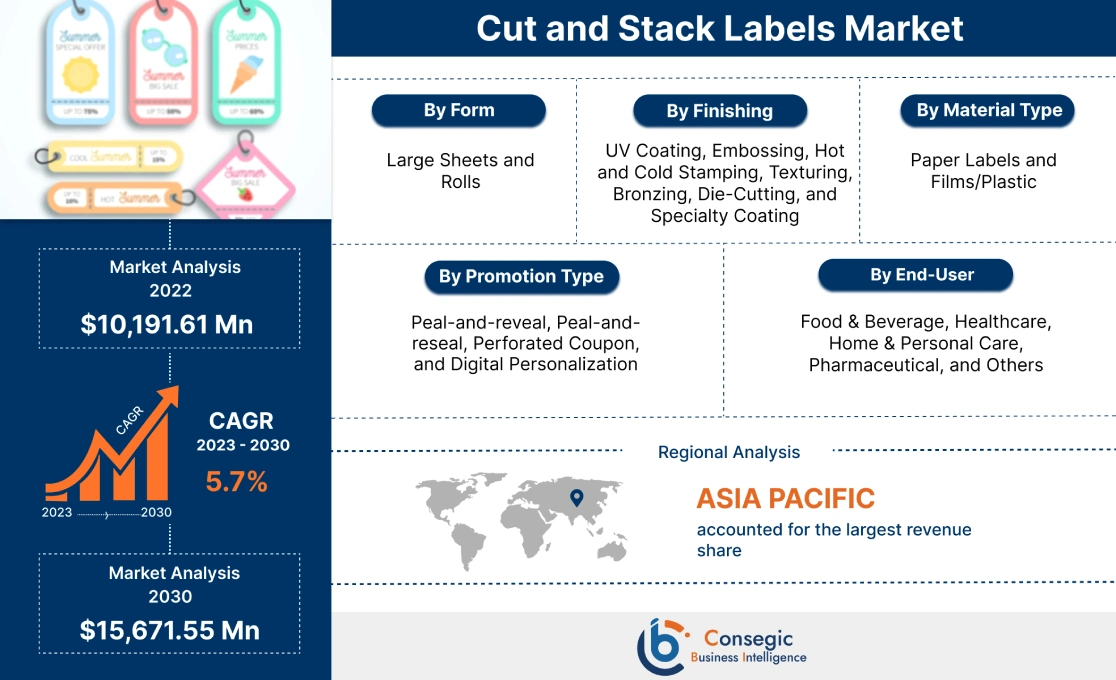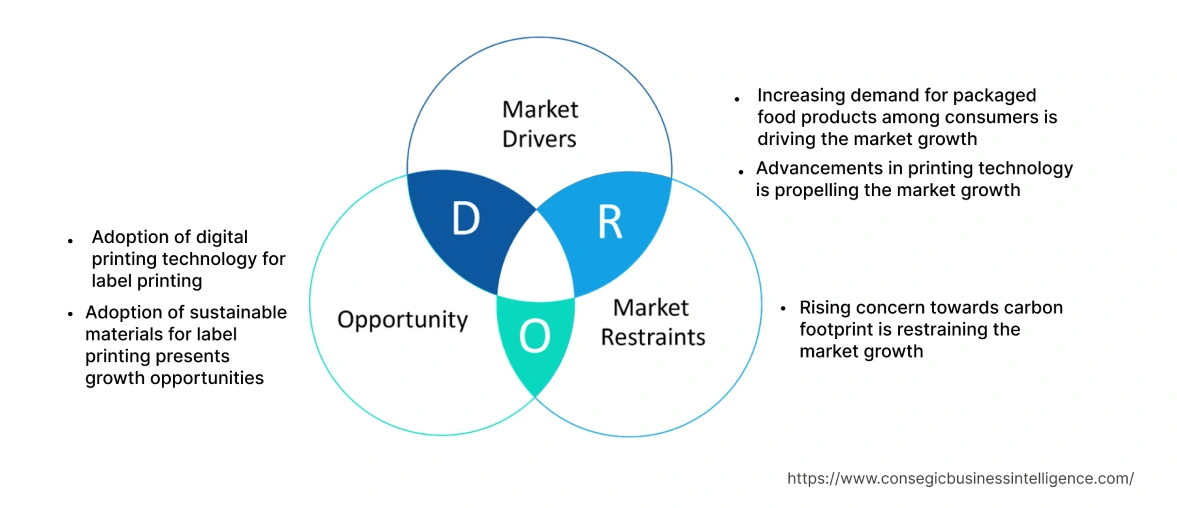Cut and Stack Labels Market Introduction :
Cut and Stack Labels Market is estimated to reach over USD 15,671.55 Million by 2030 from a value of USD 10,191.61 Million in 2022, growing at a CAGR of 5.7% from 2023 to 2030.
Cut and Stack Labels Market Definition & Overview:
Cut and stack labels, also known as glue labels, are a type of labeling technique used in product packaging. Cut and stack labels are utilized for labeling of a wide variety of products used by consumers on a daily basis such as juice containers, aerosol cans, canned foods, and other food and beverage products. Cut and stack labels are a cost-effective and versatile solution for large and mid-size quantity products.
Cut and Stack Labels Market Insights :
Cut and Stack Labels Market Dynamics - (DRO) :
Key Drivers :
Increasing demand for packaged food products among consumers is driving the market growth
The increasing demand for ready-made and packaged food products among consumers due to busy lifestyle and schedules is driving the growth of the market. The growing demand for packaged food products is attributed to the increased consumption of chips, chocolates, snacks, beverages, and frozen food products by the consumers. As a result, manufacturers are investing in attractive and informative packaging of the food products, resulting in the growth of cut and stack labels market growth. For instance, in April 2022, Nomad Foods collaborated with Innoget for the production of paper-based, clean-label packaging for frozen food products. Therefore, the increasing demand for packaged and frozen food products among consumers is accelerating the market growth.
Advancements in printing technology is propelling the market growth
The increasing adoption of advanced technologies such as printers with sophisticated Management Information Systems (MIS) is driving the growth of cut and labels market. MIS is integrated with specialized inspection and color technology, fully automated press and finishing line set-up systems. As a result, the integration of MIS software with printers produces shorter print runs, faster turnaround, greater flexibility and customization resulting in the growth of the market. Moreover, the advancements in connectivity of the label printers for efficient transmission of label designs and patterns is accelerating the growth of the market. For instance, in November 2022, Pitney Bowes Inc. launched all-in-one Wi-Fi enabled thermal shipping label printer for printing shipping labels and stamps on the products in retail industry. Thus, the increasing adoption of advanced technologies in label printing is accelerating the market growth.
Key Restraints :
Rising concern towards carbon footprint is restraining the market growth
There has been immense pressure on the labelling industry to reduce the carbon footprint by ensuring that procedures are being followed during the manufacturing process of cut and stack labels. For instance, in January 2021, Amcor Plc. introduced a new label called Reducing CO2 Packaging from the Carbon Trust for printing on Amcor product packaging to signify carbon footprint reductions. Thus, the reduction in the usage of products such as plastics and other Polyurethane products that raises environments concerns are causing an impact by decreasing the demand for plastic/film labelling. Thus, the rising concern towards carbon footprint is hindering the growth of the market.
Future Opportunities :
Adoption of digital printing technology for label printing
The adoption of digital printing technology for label printing is expected to present potential opportunities for the growth of cut and stack labels market. The utilization of digital software reduces the time and costs associated with the production of printed labels. Moreover, digital printing allows easy customization of the label design and pattern at little or no costs. For instance, in March 2023, Monotech Systems Ltd. announced to exhibit latest offerings in printing, packaging and enhancement solutions at the PAMEX 2023 by introducing RICOH digital production presses called RICOH Pro C9200, RICOH Pro C7200X, and RICOH Pro 5310S. Therefore, the adoption of digital printing technology is expected to drive the market growth during the forecast period.
Adoption of sustainable materials for label printing presents growth opportunities
The adoption of sustainable materials for label printing such as plant-based materials is expected to present growth opportunities for the cut and stack labels market. The adoption of sugarcane paper made up of 100% sugarcane waste. Sugarcane paper is expected to be used in beverage industry as it provides a luxurious look and feel to beer, wine, spirits and other high-end labels. Thus, the adoption of eco-friendly materials for label printing is expected to drive the market growth during the forecast period.
Cut and Stack Labels Market Report Insights :
| Report Attributes | Report Details |
| Study Timeline | 2017-2030 |
| Market Size in 2030 | USD 15,671.55 Million |
| CAGR (2023-2030) | 5.7% |
| By Form | Large Sheets and Rolls |
| By Finishing | UV Coating, Embossing, Hot and Cold Stamping, Texturing, Bronzing, Die-Cutting, and Specialty Coating |
| By Material Type | Paper Labels and Films/Plastic |
| By Promotion Type | Peal-and-reveal, Peal-and-reseal, Perforated Coupon, and Digital Personalization |
| By End-User | Food & Beverage, Healthcare, Home & Personal Care, Pharmaceutical, and Others |
| By Region | North America, Europe, Asia-Pacific, Latin America, and Middle East & Africa |
| Key Players | Anacotte Packaging, Resource Label Group, Blue Label Packaging, Inland Packaging, CPC Packaging, Atlas Labels & Packaging, The New Label Printing Company, Smyth Companies, Pixelle Specialty Solutions, Gallus, and Avery Products Corporation |
Cut and Stack Labels Market Segmental Analysis :
Based on the Form :
Based on the form, the market is bifurcated into large sheets and rolls. The large sheet segment accounted for the largest revenue share in the year 2022. Sheet labels are well-suited for applications that require manual or small-scale labelling. Sheet labels provide flexibility, easy handling and the ability to print labels on-demand using stand office printers or desktop labelling equipment. Thus, sheet labels allow efficient cutting of labels in predetermined shapes and sizes, resulting in elimination of wastage, thus promoting market growth.
The roll segment is anticipated to emerge as the fastest growing segment during the forecast period. Roll labels are manufactured in the form of continuous rolls wound on a core. Moreover, roll stock labels are compatible with labelling machines that apply labels onto products or packaging at a high speed. Therefore, the ability of roll stock labels to offer reduced downtime and cost-effectiveness in large-scale labelling operations is accelerating the market growth.
Based on the Promotion Type :
Based on the promotion type, the market is segregated into peal-and-reveal, peal-and-reseal, perforated coupon, and digital personalization. Peal-and-reveal segment accounted for the largest revenue share of 37.45% in the year 2022. Peel-and-reveal labels consist of multiple layers that are peeled to reveal additional information or content below the label. Therefore, the application of Peel-and-reveal labels in pharmaceutical products, food and beverage packaging, and chemical containers is accelerating the growth of the market.
Digital personalization segment is anticipated to register fastest CAGR growth during the forecast period. Digital personalization labels are designed to provide customized and personalized information on each label. Digital personalization deploys advanced printing technologies to allow variable data printing of unique text, graphics, barcodes, or serial numbers on each label. Therefore, the utilization of digital personalization technology for product packaging and promotional labeling is accelerating the growth of the market.
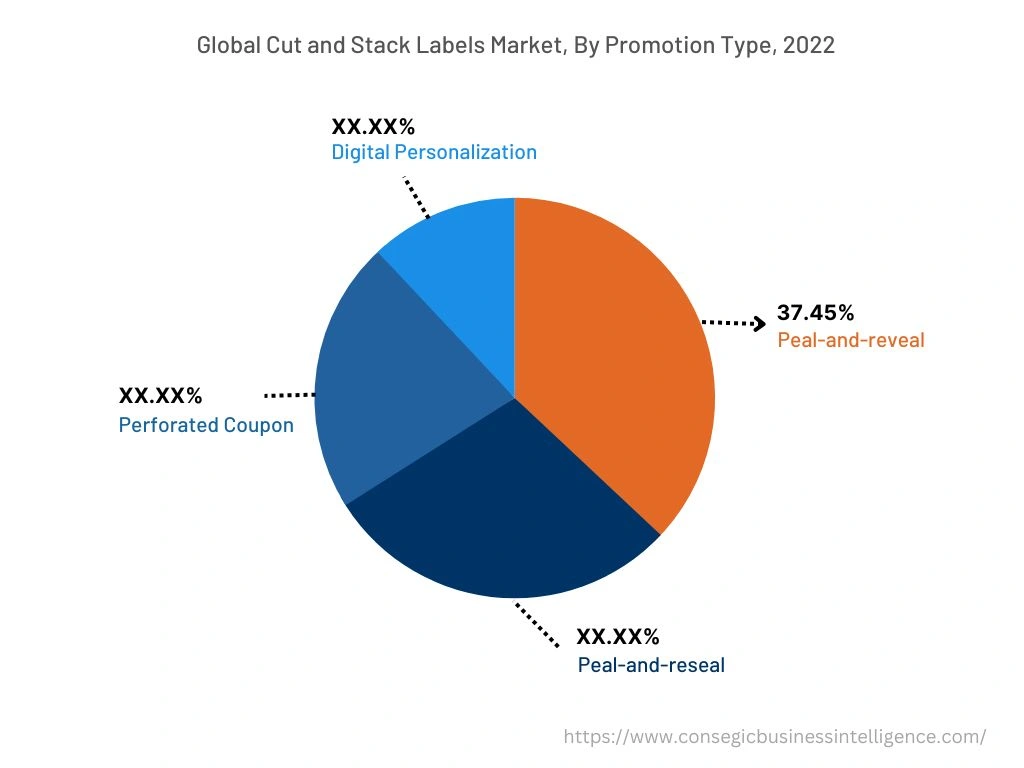
Based on the Material Type :
Based on the material type, the market is bifurcated into paper labels and films/plastic labels. The plastic/film labels segment accounted for the largest revenue share in the year 2022. The ability of plastic labels to provide durability, moisture resistance, and flexibility to the labels is driving the growth of the market. Plastic/film labels are made up of a wide variety of films, including polyethylene (PE), polypropylene (PP), polyethylene terephthalate (PET), or polyvinyl chloride (PVC). For instance, in May 2023, Taurus Packaging launched a biodegradable plant-based packaging solution made up of new plastic material featuring biocompatible polyester property. Therefore, the application of plastic labels in beverage products, personal care, and household products is accelerating the growth of the market.
The paper segment is anticipated to register fastest CAGR growth during the forecast period. Paper labels offer several advantages including cost-effectiveness, printability, and recyclability. Paper labels have the ability to withstand high-heat printing and hold ink extremely well for sharp prints. Moreover, the lower environmental impact of paper labels contributes to the growth of cut and stack labels market. Thus, the replacement of plastic labels with paper material is expected to drive the market growth during the forecast period.
Based on the Finishing :
Based on the finishing, the market is segregated into UV coating, embossing, hot and cold stamping, texturing, bronzing, die-cutting, and specialty coating. The UV coating segment accounted for the largest revenue share in the year 2022. The ability of UV coating technique to provide a glossy and high-quality finish to labels is driving the growth of the market. UV coating involves the application of a clear liquid coating to the surface of the label. The coating adds a smooth and shiny surface giving a vibrant and aesthetic appeal to the labels. For instance, in August 2021, Pulse Roll Label Products Ltd. launched PureFX Soft Touch Varnish offering a unique tactile coating to the labels. Moreover, the ability of UV coating to provide durability and protection to labels is contributing to the growth of the market.
The embossing technique is anticipated to register fastest CAGR growth during the forecast period. The ability of embossing technique to provide a three-dimensional effect to the labels is accelerating the growth of the market. Embossing creates a raised or recessed patterns on the label, thereby adding texture and depth to the design. Therefore, the application of embossing technique in high-end and luxury products is driving the growth of the market.
Based on the End-User :
Based on the end-user, the market is segmented into food & beverage, healthcare, home & personal care, pharmaceutical, and others. Food & Beverage industry accounted for the largest revenue share in the year 2022. The labels in food & beverage industry possess features such as resistance to moisture, oils, and other food-related substances. As a result, cut and stack labels are found on the packaging of food items, beverage bottles, canned products, and dairy items. For instance, in May 2022, HP Development Company, L.P. installed around 2000 printing presses in Chicago for the production of labels in food & beverage, automotive, and healthcare industry. Furthermore, the application of cut and stack labels to mention details about the product such as branding, nutritional information, ingredient lists, and regulatory compliance is contributing to the growth of the market.
Pharmaceutical industry is expected to emerge as the fastest growing segment during the forecast period. Pharmaceutical companies utilize cut and stack labels for labeling prescription drugs, over-the-counter medications, and other pharmaceutical products. Moreover, cut and stack labels are used for giving instructions to the customers about dosage instructions, warnings, expiration dates, and batch numbers. Thus, the application of film or plastic-based labels for packaging of medicines is accelerating the growth of the market.
Based on the Region :
The regional segment includes North America, Europe, Asia Pacific, Middle East and Africa, and Latin America.
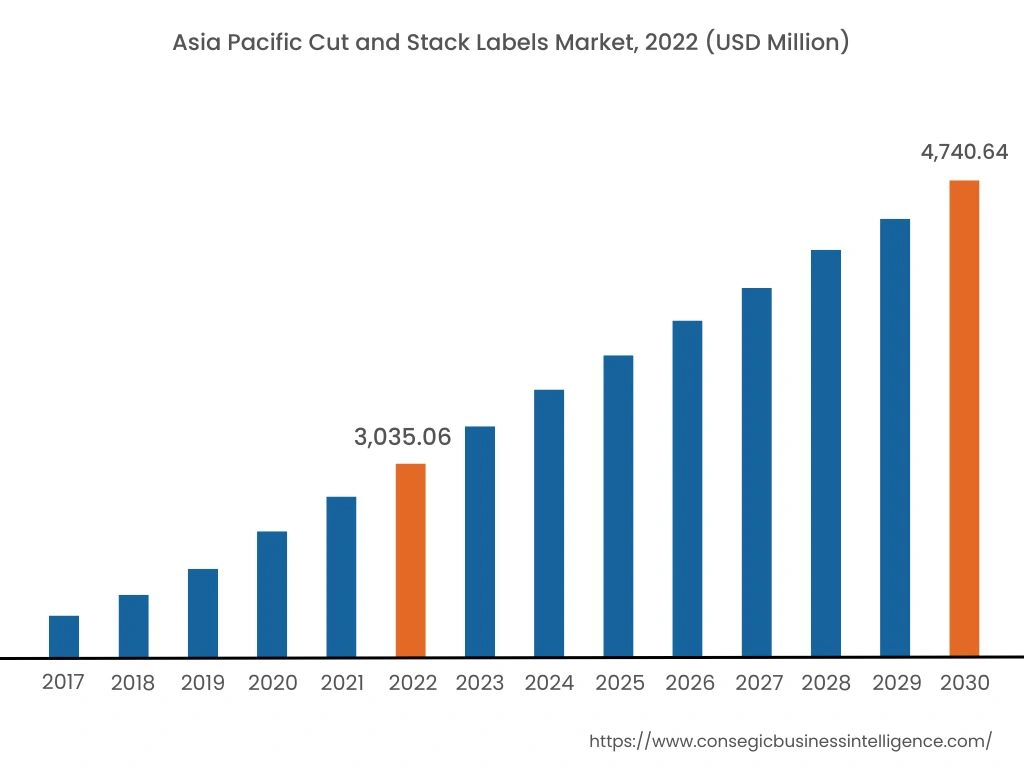
Asia-Pacific accounted for the largest revenue share in the year 2022 valued at USD 3,035.06 million in 2022 and is expected to reach USD 4,740.64 million in 2030, registering a CAGR of 5.9% during the forecast period. In addition, in the region, China accounted for the maximum revenue share of 29.65% in the year 2022. The growing awareness of branding and packaging in the Asia Pacific region has led to increased demand for visually appealing and attractive labels. Cut and stack labels offer a wide variety of patterns, design, printing techniques, and finishes, allowing brands to differentiate themselves in the market. For instance, in May 2022, Epson launched SurePress L-4733AW water-based resin ink digital label press, delivering improved automation in white ink prime label printing. Moreover, the growing manufacturing industry for a wide variety of food items, home & personal care products, and pharmaceutical products in the region is contributing to the growth of the market.
North America is anticipated to witness the fastest CAGR growth during the forecast period. The increasing adoption of ready-made food, packaged food, and frozen food products due to the changing lifestyle of consumers is driving the growth of the market. Thus, manufacturers are taking several initiatives for branding and marketing of the products. Moreover, technological advancements in the region such as digital printing, variable data printing, and specialty finishes is driving the growth of cut and labels market.
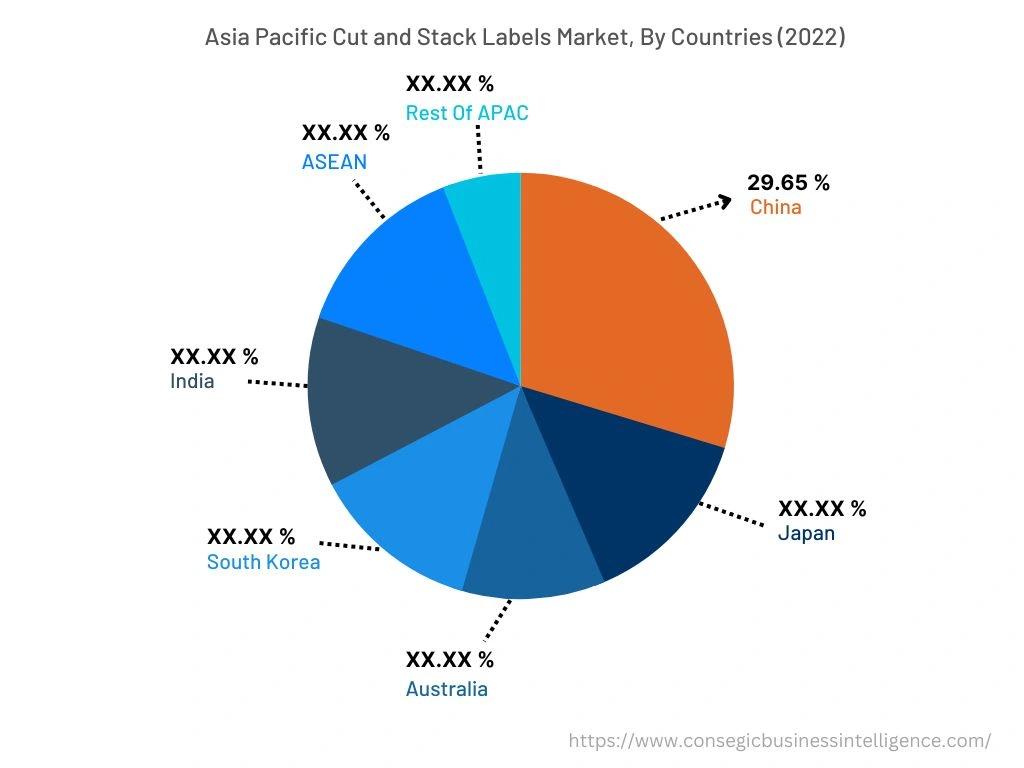
Top Key Players & Market Share Insights:
The cut and stack market is characterized by the presence of major players providing innovative and attractive labels for marketing and brand building. Furthermore, key companies are adopting several business strategies such as product innovation, research and development (R&D), and application launches that accelerate the growth of cut and stack labels market. Key players in the cut and stack labels market include-
- Anacotte Packaging
- Resource Label Group
- Pixelle Specialty Solutions
- Gallus
- Avery Products Corporation
- Blue Label Packaging
- Inland Packaging
- CPC Packaging
- Atlas Labels & Packaging
- The New Label Printing Company
- Smyth Companies
Recent Industry Developments :
- In August 2022, Gallus introduced fully digital label press called Gallus One providing high levels of press efficiency and automation, high print quality and stand-out print speeds of 70 metres in a minute.
- In June 2021, Avery Products Corporation launched heavy-duty polyester reflective labels for printing safety signage and long-range barcode labels.
Key Questions Answered in the Report
What is cut and stack label? +
Cut and stack labels are the form of stickers printed on a wide variety of products such as juice containers, aerosol cans, canned foods, and other food and beverage products for marketing and brand building.
What specific segmentation details are covered in the cut and stack labels market report, and how is the dominating segment impacting the market growth? +
By form has witnessed large sheets as the dominating segment in the year 2022, due to the flexibility, easy handling and the ability to print labels efficiently.
What specific segmentation details are covered in the cut and stack labels market report, and how is the fastest segment anticipated to impact the market growth? +
By end-user segment has witnessed pharmaceutical as the fastest-growing segment during the forecast period due to the increasing application of plastic and film labels on the packaging of medicines.
Which region/country is anticipated to witness the highest CAGR during the forecast period, 2023-2030? +
North America is expected to register fastest CAGR growth during the forecast period due to increasing demand for packaged, ready-made, and frozen food products in the region.
